#Yuzu Marinade
Text
Discover the Wonders of Yuzu: A Household Speciality!
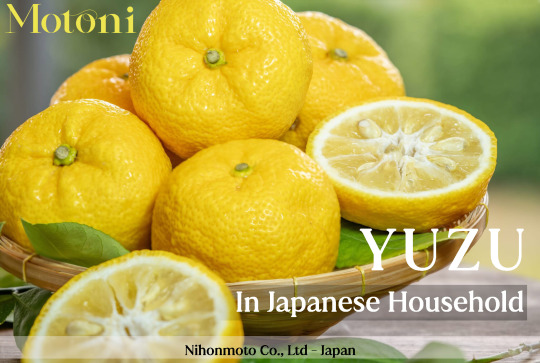
In the tapestry of Japanese culture, certain elements stand out like vivid brushstrokes on a canvas, weaving tales of tradition, symbolism, and sensory delights. Among these treasures is Yuzu, a citrus fruit cherished not only for its tangy flavour but also for its deep-rooted cultural significance. Join me on a journey to unravel the layers of meaning behind this humble yet remarkable fruit, as we explore its role in rituals, Japanese cuisine, and the collective soul of Japan.
You might know of the famous Yuzu-yu tradition that takes place in Japan. Where people enjoy a good Yuzu bath it is one of the famous practise that is followed and loved by the Japanese people but I am going to talk about the small traditions that occur in a normal household of any Japanese family involving Yuzu. These traditions are the reason why most of the Japanese respect and adore this little fruit that has so much to offer.
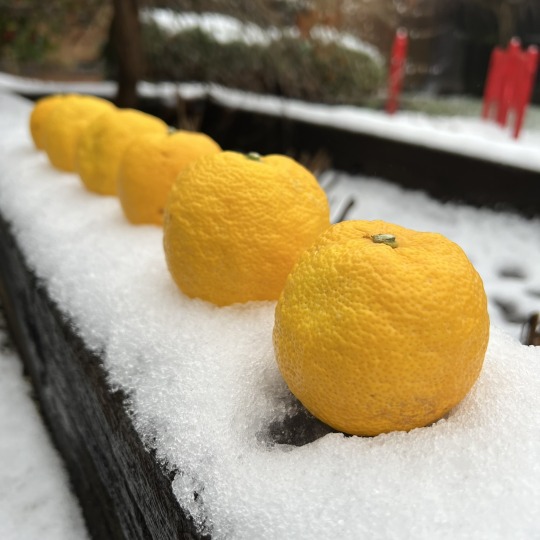
Yuzu is considered a symbol of Prosperity and Good Fortune although not in the same way as other symbols like the Japanese lucky cat (Maneki-Neko) or the pine tree (Matsu) but during New Year's celebrations Yuzu is often used as a decoration symbolizing freshness, vitality, and purification for the coming year. This shows the trust for Yuzu among the Japanese People. Yuzu branches are displayed in homes as well as public spaces. They are often arranged in vases or decorative containers, the green leaves and bright Yuzu fruit look elegant and enhance the festive ambience.
In many regions of Japan whenever a Yuzu dish is cooked in a household it is always shared with the neighbours symbolizing the affection, togetherness and common love for Yuzu among people. It is almost considered a small occasion if you get a Yuzu dish from your neighbours. After all who doesn't like a good Yuzu Marinade or Yuzu Sweet dish. Particularly during the Winter season, hot soups and stews with Yuzu Flavour are cherished. Made from yuzu zest and chilli peppers, Yuzu kosho is a spicy condiment, prepared in a Japanese household which is also commonly enjoyed during winter to add warmth and flavour to meals.
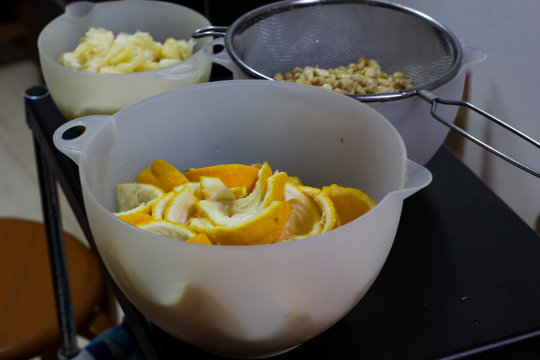
People in Japan also preserve Yuzu by making yuzu vinegar, yuzu marmalade, or drying yuzu peels for later use. Another inseparable part of the Japanese household is Yuzu-cha or Yuzu Tea. In Japan, Yuzu cha is made primarily from yuzu fruit, honey or sugar, and hot water. Optionally, additional ingredients like ginger or cinnamon may be added for extra flavour and warmth. It is a very refreshing drink consumed very often but this hot Yuzu cha is enjoyed by Japanese people, especially during cold winters. They take Yuzu-cha in small teacups or larger mugs, depending on personal preference and enjoy its flavour and warmth with comfort. Some people also like to have it chilled during warmer weather.
Yuzu is hence called a versatile ingredient and has a big role in the Culinary and Festive culture of Japan. It connects people to seasonal traditions and rituals. Yuzu has been getting immense love from households in Japan over the past so many years. Its flavour and exotic taste are deeply rooted in Japanese people's minds and its spectacle brings a feeling of homeness in their hearts. Overall, it is a cherished ingredient and cultural symbol deeply ingrained in Japanese culture.
#citrus#Japanese culture#Japanese#tradition#Japanese household#Yuzu#citrus fruit#fruit#soul of Japan#Japanese cuisine#Yuzu-yu#Yuzu bath#Prosperity#Good Fortune#New Year's celebrations#festive#Yuzu dish#Yuzu Marinade#Yuzu Sweet dish#Winter season#hot soups#yuzu zest#Yuzu kosho#flavour#yuzu vinegar#yuzu marmalade#Yuzu-cha#Yuzu Tea#refreshing drink#comfort
0 notes
Text

Went to Japanese restaurant near me called Jimotti's yesterday. And yeah the ramen was good. BUT THAT GROUPER SASHIMI. It was so textured and complex. Just a simple yuzu sauce as a marinade and the smallest scallop of wasabi. Like goddamn
3 notes
·
View notes
Text

Part of the grocery order that came in yesterday evening. All of these were sale items, and we have two (smallish) packs of pork chops plus an accidental two bunches of green onions. That's only one of them, and some of the onions themselves are pretty big. Good thing they do hold well in water, but guess we're getting plenty of green onions for a while!
These are also some of the fresh items that I thought should be used the soonest, and no reason they couldn't profitably go together. So, quasi-Japanese is looking good tonight! Mr. C also remembered to pick up some sake from Systembolaget the other day, so we should be better set for that.
With a side dish of pseudo-Chinese cucumber salad on the side, currently marinating itself in the fridge. Using some of the green onion, naturally. I just sliced the cucumber fairly thickly this time; it's all good.
A great use for the oyster mushrooms and at least a couple of the shiitake (plus another big green onion instead of the regular onion!):
youtube
JAPANESE SPAGHETTI with Mushrooms (Easy Pasta Recipe)
(Another version of kinoko pasta with bacon, from Hiroko Liston who also has a bunch of solid recipes.)
Since I don't have any plans in the near future for the rest of that pack of shiitake, I'm thinking of just drying what's left for later. That does tend to work out well, and we don't have any dried ones right now. Couldn't pass up the deal even without immediate plans for all of them! 😊
As for the pork chops, the one pack is also chilling out in a Ziploc in the fridge with a variation of this miso marinade:
I actually threw some lemon pepper seasoning in there instead of the yuzu chili paste, because we have it and it ought to taste fine--if in a rather different slightly spicy citrus direction. The basic marinade would also be awesome with just some garlic and ginger instead, and/or using chicken instead of pork. I am also planning to just quickly sear those thin loin chops in a skillet, then reduce the marinade in the same pan teriyaki style.
(Will I blame Nami if any of my monkeying around with her recipe goes horribly wrong? Not hardly! But, it should hopefully be all good, from previous experience cooking similar things.)
A little more work overall than I was planning on today, but hopefully worth it for a nice fresh meal.
#food#recipes#japanese inspired#pasta#noodles#mushrooms#cucumber salad#pork chops#chinese inspired#clatterbane's half assed cooking show#gluten free#Youtube
3 notes
·
View notes
Photo


More cooking from comic books.
T.E.S.T. Kitchen #3 by Paul Eschbach had a recipe for barbecue chicken, corn bread, and coleslaw.
I had a couple of substitutes. The main one being I am a terrible Australian and I don't own a BBQ. I had to use my oven. I couldn't find corn meal here anywhere so I went half masa and half polenta. I also couldn't get straight yuzu preserves, so went with Yuzu and Grapefruit. (I also cooked a vegetarian roast with the marinade and glaze as well as a chicken. It worked well.)
I think American BBQ is too sweet for my Australian family. It was a good recipe, the heat of the Korean chilli's really cut through the sweet, but the main complaint we all had was it was too sweet. I was assured the chicken was amazing the next day and honestly that was the nicest cornbread I've ever had. We all liked the coleslaw.
#marvel#avengers#food#t.e.s.t. kitchen infinity comic#marvel comics#recipe#bbq#cooking from comics#paul eschbach#comics
6 notes
·
View notes
Text
Le Yuzu : la surprise acidulée orientale
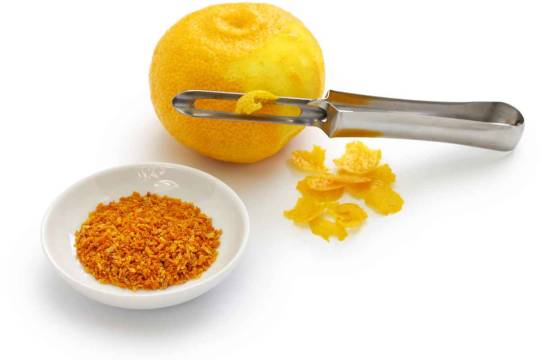
On pense que le yuzu est originaire du bassin supérieur du fleuve Yangtze en Chine. Il a atteint le Japon en passant par la péninsule coréenne quelque temps avant la période Nara. Il a prospéré il y a environ 1300 ans et a été cultivé dans l'ouest du Japon pour être utilisé comme médicament. Actuellement, le yuzu est cultivé en Corée, en Australie, en Espagne, en Italie, en France et en Chine, son pays d'origine. Cependant, les yuzus produits au Japon ont un arôme riche et inégalé, car ils ont été cultivés principalement dans des zones montagneuses intérieures, où il existe un écart de température important entre le jour et la nuit.
Les branches de l'arbre à yuzu sont couvertes d'épines extrêmement pointues qui endommagent souvent les fruits, notamment en cas de vents violents. Cela a contribué à l'idée que le yuzu est difficile à entretenir. Les yuzus sont connus pour leur lenteur de croissance et la "méthode de culture Misho", qui consiste à cultiver à partir de graines, nécessite 15 à 20 ans avant que les yuzus puissent porter des fruits. Pour cette raison, cette méthode de culture n'est pratiquée que dans l'une des zones de culture les plus traditionnelles.
Il existe plusieurs théories sur l'origine du nom "yuzu", mais la plus célèbre explique que le caractère "yu" (tel qu'il est lu en japonais) est un mot chinois désignant le yuzu et que "su (zu)" signifie vinaigre, auquel le yuzu était souvent substitué, ce qui a conduit à la création du terme yuzu.
Le yuzu : une touche d'exotisme à votre cuisine
Le yuzu est un agrume originaire d'Asie et qui se rapproche du citron. Il est très prisé pour son goût unique et sa saveur acidulée. Sa chair jaune, fine et juteuse, est très aromatique et sa peau très parfumée. Il est souvent utilisé pour relever les plats, mais aussi pour la confection de desserts ou de boissons. Le yuzu est donc un excellent allié pour sublimer vos recettes et leur apporter une touche d'exotisme.
Sa pulpe est très appréciée pour ses vertus antioxydantes et sa saveur acidulée. Elle est parfaite pour aromatiser des sauces, des vinaigrettes ou encore des marinades. On peut également l'utiliser pour confectionner des desserts, comme des tartes ou des gâteaux, qui seront alors délicieusement parfumés et acidulés. Le yuzu est donc un ingrédient très pratique et qui se marie à merveille avec de nombreux plats et desserts.
L'écorce du yuzu est également très intéressante car elle peut être utilisée pour parfumer des plats salés ou sucrés. Elle est particulièrement adaptée pour aromatiser une tarte, qui sera alors subtilement parfumée et très agréable en bouche.
Le Yuzu en cuisine
Comment cuisiner avec le yuzu ?
Il se rapproche du citron mais avec des notes plus douces et plus subtiles. On peut le consommer cru ou en jus, mais aussi le cuisiner pour obtenir des recettes délicieuses. Une salade composée de légumes frais et de quelques olives noires, agrémentée d'une vinaigrette à base de yuzu, est un délice.
Le yuzu apporte une touche acidulée et parfumée qui sublime la salade. On peut également ajouter du yuzu à des salades plus classiques pour leur donner un goût unique.
Pour les amateurs de tartes, le yuzu est aussi une excellente idée. On peut le mélanger à de l'huile d'olive et du sucre pour obtenir une pâtesucrée et parfumée. Une fois la tarte cuite, on peut la décorer avec des tranches de yuzu frais pour un résultat encore plus savoureux. Pour un plat plus élaboré, le yuzu se marie parfaitement avec le gingembre et le poulet.
On peut le mélanger à de l'huile d'olive, du sel et des pépins de yuzu pour obtenir une sauce parfumée qui accompagnera à merveille les morceaux de poulet. Une recette simple et savoureuse qui ravira petits et grands !
Le Yuzu, grâce à sa fraîcheur et sa pointe d'acidité, permet également de rendre plus digeste certaines recettes que certains peuvent juger bourratives, comme le cheesecake (dont vous trouverez une recette ici) ou encore des tartes au citron meringuées.
Découvrez ses bienfaits
Le yuzu est riche en vitamine C et en acides organiques qui aident à renforcer le système immunitaire. Il contient des antioxydants qui peuvent aider à prévenir les maladies cardiovasculaires et le cancer. Enfin, il est également riche en vitamines B et en minéraux qui sont essentiels pour une bonne santé.
Pour profiter des bienfaits du yuzu, il est recommandé de le consommer frais ou sous forme de jus. Vous pouvez également l'utiliser pour aromatiser vos plats et pour ajouter une touche d'acidité à vos recettes. Le yuzu peut également être utilisé pour préparer des thés et des infusions qui sont bons pour la santé et qui ont un goût délicieux.
Riche en vitamines, le yuzu est une excellente source de vitamine C et contient également des antioxydants qui aident à protéger le corps contre les radicaux libres. Il est également riche en acides gras mono-insaturés, comme ceux trouvés dans l'huile d'olive, qui sont bons pour la santé cardiovasculaire et qui peuvent aider à réduire le risque de maladies cardiaques. Enfin, le yuzu est connu pour ses vertus anti-inflammatoires et antiseptiques, ce qui en fait un aliment très bénéfique pour la santé.
A lire également : Prendre des cours de cuisine asiatique en ligne
Avec quelles recettes essayer le Yuzu ?
Pour commencer à apprivoiser ce nouvel agrume, il est suggéré d'essayer des recettes au sein desquelles son intégration est facile. Voici quelques exemples :
- Panna cotta vanille au coulis de Yuzu
- Tarte meringuée au Yuzu
- Crème brûlée au Yuzu
- Salade de concombre, melon d'eau et Yuzu
- Tataki de thon au jus de Yuzu
Read the full article
0 notes
Photo

Soy-yuzu marinaded steak Check this blog!
10 notes
·
View notes
Text
Bulgogi Icecream
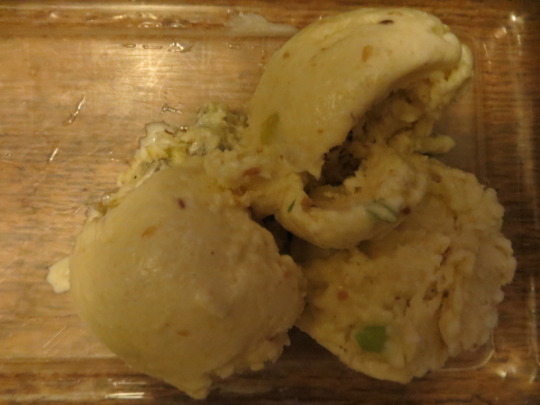
So, for those who are not Korean and want to steal this recipe and for the people who want to take credit for it: I am not your invisible unnamed PoC friend that you happen to know and have stolen the recipe from, yet somehow managed to sell this FREE recipe to a website. If you do that, after my working on this recipe for literal months of gathering resources, reading up, etc, then I’ll be very upset at you. We are not friends, then are we? If you are white, you stole from a PoC, then double the shame, you imperialist. Stop stealing PoC recipes and claiming that you are friends and then making the recipe as white as possible. If you don’t know that, you definitely aren’t my friend and aren’t listening to my wishes, which makes you culturally appropriating. And before you say it, the origin of Ice cream is not from white Europe.
I had the idea in 2019, but managed to complete the development in 2020, after a lot of failure. I’d been thinking about pioneering this recipe long before then, but lacked the finances to do so.
People stole my recipes before... so let’s see if they want to attempt it again. (Yes, Copyright does not protect recipes, but it doesn’t make you less of a donkey for doing so and then claiming it’s an invisible friend that gave you the recipe. No. It’s here. Link it and have respect for recipe development.).
But WHY?
I saw a recipe years back on kimchi ice cream, and I was super curious if it could be done with other Korean foods. I made jokes about Bulgogi Ice cream, but didn’t have the time or money to actually make it. I pioneered this recipe, because I found out there was kimchi ice cream, green tea ice cream, Philli Cheese Steak Ice Cream, garlic Ice Cream, honey ice cream, sesame seed ice cream, soy sauce ice cream, green onion ice cream, ginger ice cream, onion ice cream, but not a single soul had thought of Bulgogi Ice Cream. I checked in hangeul and in English. And well, me who has an ice cream maker and made Triple Yuzu Gooseberry Liquor Yogurt Cheese Ice Cream had to try and see if it was possible. It tastes excellent.
I’ve watched enough cooking shows and read cooking books, read up on food science enough shows to sink a ship, so I knew the basics in order to get it to work. But I did fail the first 3 times. (Which because of my finances took a month between before I could attempt again.)
Words of caution
This ice cream might take longer to congeal than “normal” ice cream. Do not mess with the salt ratios, except to cut them down.
History of Bulgogi
Bulgogi, for those that don't know is a Mongolian-imported and Korean-adapted dish. It technically isn't "true" Korean food, but one that most likely came during the Goryeo period. It is marinaded meat, mostly beef and comes with samgyeopsal, or Korean BBQ, also a Mongolian Import.
There are other types of bulgogi as well, which include pork and chicken, but the composition of those is different from the one with beef and would need a separate recipe.
Recipe Development
I tried the first time going wholesale and pouring the whole of the bulgogi in, but the soy sauce failed to let it set. There was too much salt. But one should not give up when they have a recipe in mind, so knowing some food science, I tried stab two, which was to deconstruct the bulgogi, take out the soy sauce (mostly) and reconstruct it again in the ice cream. This worked better, but it still was more of a slurry and failed to set properly. The third try, I reduced the egg yolk by one (since egg yolks influence freezing), and added mejukaru to try to make up for the lack of soy flavor and reduced the soy sauce again.
The reason I used Spencer beef versus other types of meats is because it has a nice chew, less gristle and nice marbling. One can use something else, but there is something satisfying about chewing the ice cream. An acquaintance of mine was pretty insistent that it have a swirl, so I thought that up too.
Soy milk and rice milk ice cream base can be used instead, as necessary.
Mejukaru Meju is a block used normally to make soy sauce and is prefermented. Meju karu is the powder made from the fermented block. It can be found in most korean grocery stores. It will give a milder flavor of soy sauce without the hazard of excess salt softening the ice cream. It is optional since some people don't like the taste of soy and some people are allergic to soy.
One caution I have is to not go overboard with the soy sauce. The leftover marinade once thoroughly cooked can be used for other meats like pork, chicken, beef again, and to season tofu. The emphasis here is to make sure you cook the sauce thoroughly. I made the mistake of putting the sauce into the ice cream and it failed to set. Do not repeat my mistake, thinking it's a waste.
On Soy allergies
This is not medical advice, seek a real medical professional: Most soy sauce does not cause soy allergies since most of the soy breaks down, but if you need to sub the soy sauce, I would consider something like a mild fish sauce, which has a similar flavor profile. (same proportion). The other option is to make soyless soy sauce from scratch, but that’s unlikely.
On having Crohn's Disease: There are soy sauces without gluten in them. I make my own soy sauce and often cut out the wheat. It can be done. You can sub for 2 tsps 100% soybean powder, but the meat might not be as tender.
Bulgogi Ice Cream
Ingredients:
1/2 package of Beef, sliced spencer cut into 1/4 inch squares
Bulgogi Sauce Ingredients:
2 tbsps cup sesame seed oil
2 tbsp Soy sauce
1 head of garlic minced.
1 thumb of ginger, minced.
2 tablespoons honey
2-3 tbspoons sesame seeds
Ice cream ingredients:
3 egg yolks
1/2 cup granulated sugar
1 cup whole milk
2 cups heavy cream
2 teaspoons vanilla extract or vanilla bean paste
Ice cream Flavorants:
1 tbsp honey
1-2 clove garlic, ground
1 thumb fresh ginger peeled and ground
1 tbsp toasted and ground sesame seeds
1 tbsp toasted sesame seeds.
2 scallions, blanched (They can also be skillet fried in sesame seed oil--no soy sauce if you prefer to caramelize them)
(2 tbsps mejukaru)
Optional Swirl Ingredients:
3 tbsp honey
1 clove garlic, finely minced
1/2 thumb ginger
2 tbsp toasted and ground sesame seeds
2 tbsps heavy cream

Make the Bulgogi:
Combine the sauce ingredients: sesame seed oil, soy sauce, garlic, ginger, honey, sesame seeds. Stir it together. Add the cut up beef. Marinate for at least 1 hour. Cook the beef and sauce. (Sauce once cooked can be used for other things)
Strain the beef. Put in freezer.
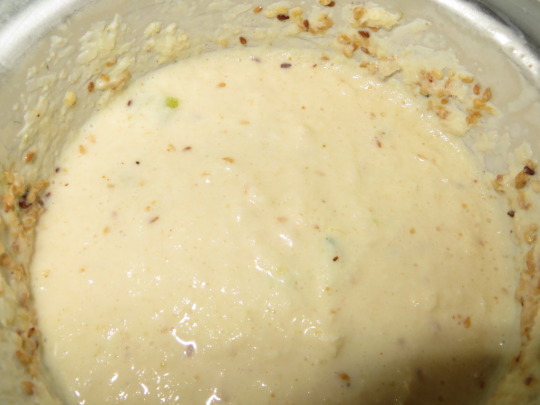
Make the Ice cream custard:
- Add egg yolks and sugar to a medium saucepan and whisk until light yellow color and well-combined. In another small saucepan, heat milk until it begins to simmer. Gradually add milk to egg and sugar mixture, stirring constantly. Heat mixture until it reaches 165, but do not allow to go to a boil. As soon as it reaches the correct heat, remove and add vanilla. Combine with the ice cream ingredients and bulgogi. Refrigerate for an hour. Pour into ice cream mixture. As the mixture is combining in your ice cream maker add the heavy cream.
The ice cream might take longer to set if you do not have an electrical machine with a auto freezing mechanism, so put into the freezer and check on it every few hours and stir.
If you want a swirl:
Combine the swirl ingredients, as the ice cream congeals pour last.
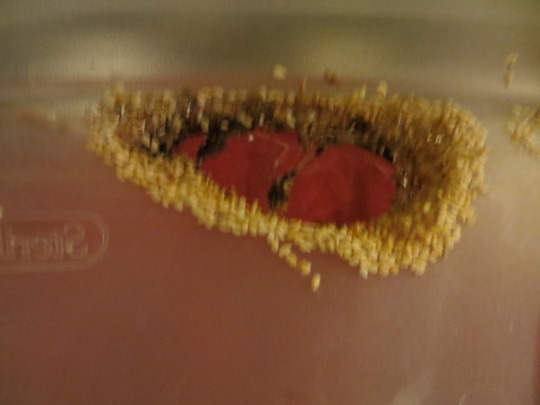

Notes: DO NOT add too much soy sauce, the ice cream will fail to set.
Sesame seeds melt plastic in the microwave. If you want to toast them do it in 30 second bursts in a non-plastic container. And yes, microwave safe plastic will also melt.
2 Recipes for the leftover Bulgogi sauce:
Combine leftover egg whites and leftover bulgogi sauce together with a whisk. You can eat this OR
combine with meat of choice, coat with panko and deep fry.
It also can be made into more bulgogi and then the bulgogi and sauce made into japchae.
8 notes
·
View notes
Photo
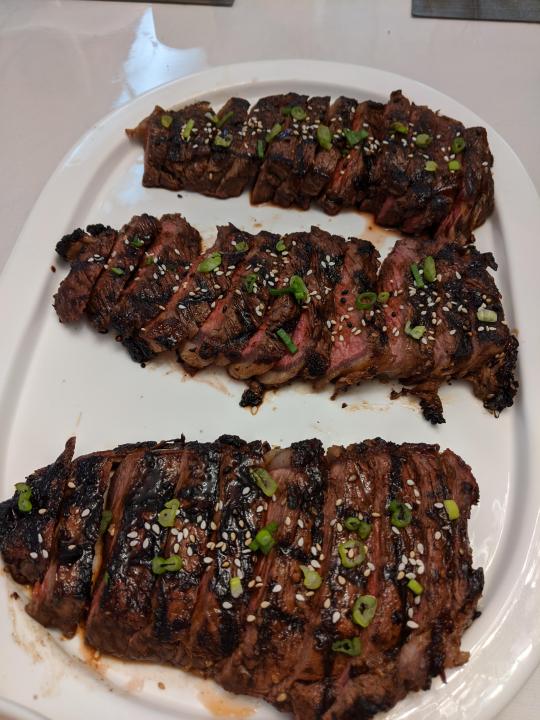
Soy-yuzu marinaded steak
Source: https://reddit.com/r/foodporn
http://foodmyheart.tumblr.com | https://campsite.bio/foodmyheart
32 notes
·
View notes
Photo
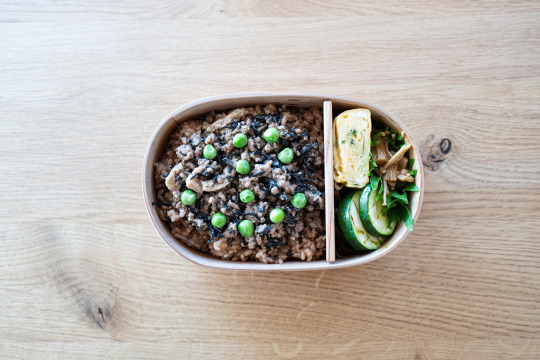
It’s like a green Obento. But it’s OK - now we are new green season. Egg cake has Aosa (Okinawa seaweed) inside. Early Zuccini is grilled on Grill Pan, and marinade with salt, olive oil and Yuzu peel.
Brown Rice with 28 grains
Meat and Seaweed, green peas.
Egg cake with Dashi and Aosa
Name Take
Grilled Zuccini
Seaweed Tsukudani (hidden)
2 notes
·
View notes
Photo










I love New York. I love drinking. I abso-fuck*n-lutely love drinking in New York. I love it so much I went to New York just to drink - caution: this trip is not, and I repeat, not for everybody. I mean, what’s not to love about drinking in New York?! The endless supply of bars; the attractive, charming and talented bar staffs, and let’s not forget the beyond delicious libations they serve up ‘til 3 (even 4) AM on a Monday - astounding, especially when you come from a small town where last call is 12.45, if you’re lucky. Before our trip, we agreed on the ‘one-drink-one-bar-rule’ - a rule that we slowly abandoned as the night progressed. After what felt like a 12 hour commute from YVR, I arrived in Penn Station, starved and parched. A quick change and a touch up later, I finally made it to dinner at WildAir: a hip, trendy, wine-focused Lower East Side restaurant from the boys who opened the Michelin-starred Contra. The food menu is a fairly simple: tartare, mushrooms, clams, and allegedly out-of-this-world fried squid. The wine list, on the other hand, is extensive and edgy. If you’re into the whole natural, skin-contact wine situation like we are, you’ll probably see us there again with a bottle of Susucaru, snacking on some fried squid. A couple blocks down from Wildair, is Bar Goto. A cozy Japanese bar with a MOOD AF lighting, brought to you by Kenta Goto, a Pegu club alumn. The man himself made me a plum Sazerac the last time I was in. It easily became one of those cocktails you crave over and over again. So naturally, I got one, and another one for good measure. The whisky finally kicked in. With a little buzz and a much better mood, we made it to Death and Company and put our name on the list. Wait time was about an hour and 30 mins, enough for a cocktail or two at Angel’s Share – or so we thought. It’s another 45 mins wait for us, but luckily, they have a sister bar next door that’s much less crowded, a little brighter, and slightly more peaceful. Our new friend Ryan, who’s bartending that night made me a ‘Bewitched’, a riff on Old Fashioned with grilled and spiced truffle-infused whisky, cognac, Kokuto syrup, bitters and Kaffir lime leaf. It’s as decadent as it sounds. Stunning mixture of flavour, texture, and aroma on each indulgent sip. It was on point. It’s finally time for us to get to Death and Co. Their Manhattan’s been calling my name since September last year. Everything about Death and Co’s Manhattan is perfect: the bourbon, the vermouth, the ratio, the temperature, just everything. Say what you want (I actually got into an argument on this) but this, is the best Manhattan in Manhattan. The night spiralled down the rabbit hole after the next drink, a Boulevardier - I remember we had two more cocktails there, but I can’t, for the sake of me, remember what they were. I know there was gin, somewhere, somehow. I won’t bore you with the details of our challenging journey home so let’s skip to the morning after - two bottles of Pedialyte, two advils, and a hot shower later. Our mind was focused on a bougie-ish scrambled eggs and caviar at Buvette, and so was the whole West Village apparently. “50 minutes” - the cute European host said. Other people would typically take this time to walk around, maybe get an oat-mylk latte and a croissant. Since we’re no ordinary people, and it just so happened that their sister bar ‘Pisellino’ just opened down the street (what a coincidence), we kinda had to stop by for a drink. It’s 1145, and in front of me was a full, frosty glass (and a mini carafe) of dry martini with olive and twist on the side. What a perfect West Village morning: sunny, breezy, and boozy. By the time we sat down for breakfast, I was a little buzzed, again. But nothing a plate fluffy scrambled eggs and caviar, waffle with berry compotes, croque madame, and another bottle of bubbly rosé can’t fix. We then spent the afternoon roaming around Soho, shopping for all the things we convinced ourselves we desperately needed - Hello new Thom Browne fragrance! It’s a quarter to eight, we were dressed to the nines, ready for a 10/10 night out in New York City. Our plan to have a chic pre-dinner cocktail at Polo Bar was cancelled because someone (aka me) forgot to call and make a reso, and it was packed there. We had to settle for the King Cole Bar across the street where the drinks were meh and the price tag was awfully expensive (no more $25, bland, overly spicy Red Snapper for us) - I went in purely to relive my Andy Sachs’ Harry Potter unpublished manuscript moment and nothing more. Dinner tonight was at the hyped up Korean steakhouse Cote in Flatiron. The one Michelin-starred restaurant is all about high quality meat, delectable side dishes, and impressive wine list (Their beverage director is such a star!). Here’s the thing, if you can make a hanger steak taste so succulently delicious, you’re doing something right. That’s exactly what they do at Cote. The steak (aside from the Galbi) is prepared in the simplest fashion: heat and salt, no marinade, no spices, no nothing - it was perfect. The service was impeccable, the timing of each dish was flawless. With a tummy filled with steak, scallion salad, and rice, we decided to walk our way back to the West Village - seemed crazy far, but at that point, it was necessary. We made it to Dante, who recently crowned #1 bar in the world, so naturally it was very busy. The apero-focused bar is famous for their ‘Negroni Sessions’, which is impressive and can be adventurous. From the most classic, to the most unexpected variation with tequila, banana and pineapple shrub, they do it, and they do it well. If you’re in the mood to splurge (we weren’t lol), their vintage martini is absolutely worth the $65 price tag (the Plymouth gin from ‘60s alone is drool-worthy). I, decided to go for the Olivette: a savoury, brine-y, less serious cousin of the vesper. We then visited Katana Kitten. Another bar in the village that scored a spot in this year’s 50 Best Bars, number 14 to be exact. It’s a fun (the owner Masahiro Urushido is also quite a legend), non pretentious neighbourhood bar with playful and whimsical cocktails. I obviously started with a Hinoki martini, yet another variation of the vesper, while Handika was having a slushy, boozy, crushed-icy ‘dessert’ (didn’t count as a drink, apparently). It was difficult to have just one drink here: would you skip on a yuzu-sisho daiquiri? how about a genever-based negroni with umeshu? or a calpico swizzle? Ya I don’t think so either. We had one of each, plus a another sisho G&T, and the classic highball. YOLO. For the sake of settling our argument on the best Manhattan in Manhattan, I invited Doris to join us at Employees Only across the street from Katana Kitten, conveniently. By the time we saw each other, my Manhattan was gone, and I was drinking a Monkey 47 martini yet again. That’s about all I can recall from that night. Oh wait, there was a tequila shot and another Manhattan - the end. Monday morning - not enough Pedialyte, water nor Advil in the world to bring me back to life. I, somehow, managed to meet Patrick for coffee, had a bite of a mushroom toast, and stayed alive. I made it back to the hotel just in time for a much-needed nap before check out and a trip to Williamsburg for lunch. It was rough. I kept telling myself another lie of “I’m never drinking again” for the 30 minute subway ride to Peter Luger. Peter Luger is a classic: steak (yes, another one), burger, with a side of onion, tomatoes, and fries. We then gathered enough energy to get to DUMBO for a picture of two (hundreds) before saying goodbye to each other - sad. I zipped back downtown for a meeting. A VERY EXCITING MEETING. I got the pleasure to visit the Bon Appetit test kitchen, thanks for the my lovely host Chris Morocco (Yes - we’re friends now HA!). it’s only appropriate that I wore my ‘Thirsty for Andy’ t-shirt - Andy was there, and we obvs. bonded over my OOTD. Claire was doing her ‘Gourmet Makes’, Carla was there, Molly too, Oh I also got to meet Alex Delany and Em Scultz too. It’s a casual Monday afternoon at BA test kitchen. It’s now cocktail hour and the one man I got to meet this time was the man everyone needs in their life: mister Steven Huynh himself. An instagram-turned-real-life-friend that I’ve known for 7 years. We met for the first time that night and we got along over dry martini-inspired cocktails and crudité at Thomas Keller’s TAK room (in the Hudson Yards). Sitting at the bar at TAK room feels luxurious but not intimidating. The bar team was friendly, interactive, and passionate about amaro. They even took us downstairs to check out the vintage amaro collections at their speakeasy, Bookbinder. After a snack break, we visited David Chang’s new restaurant Kawi downstairs. Steven had a pineapple rum daiquiri, I, had a ‘New Fashioned’ - a play of the classic Old Fashioned with coconut-washed Japanese whisky, sencha and bitters. It was delicious. The buzz is back on, and I felt so much better (HA!). Our next stop was The Nomad Hotel - our absolute favorite. We felt like we’re home right away, especially after a delicious Monkey 47 martini (Nobody’s counting, right?). Zanib joined us later that night for a negroni, and of course, I had to refresh my almost empty drink. Another friend Erik joined us for one more drink. Things started to get blurry real quick, I recall there was a Manhattan, a Brooklyn, a rum cocktail of some sort, fried chicken, and a Macallan 12 at one point before we’re back in the car for a nightcap at Blacktail. A tiki-focused sister bar of Dead Rabbit. We’re welcomed by a pink slushy daiquiri, and the bartender made me a delicious, stirred rum cocktail to sip on - don’t ask what it’s called. I finally tapped out and made my way back to Brooklyn. With close to zero voice, I got to Newark and flew back to Vancouver via. Denver - yes, I made a stop to Death and Co for a Sazerac-esque cocktail called the Uncanny Valley and a lobster ceviche. Here I am two weeks later, still recovering from the worst sore throat of my life, slowly getting my voice back (still can’t hit Mariah’s note tho :s). Will I do it again? ABSOLUTELY! Thanks for the amazing time New York - until next time!
#New York#Travel#Travelblogger#Imbibe#cocktail#cocktails#travelblog#NYC#Bonappetitmag#Bon Appetit#Vancouver#Vancouver Blogger#Dante#Death and Co#UES#popular#radar#iphone#iphoneonly#fashion#food#food blogger#drinks#foodblog#menswear#mensfashion
7 notes
·
View notes
Text
Decouverte du patrimoine de Tokushima a la Maison de l UNESCO

©TokyoatParis
Le département de Tokushima n’est pas connu que pour l’un des matsuri les plus célèbres du Japon, l’Awa Odori. Il est aussi le berceau d’une gastronomie riche et de bien d’autres patrimoines culturels comme naturels à découvrir en toutes saisons.
Je vous présentais la semaine dernière un aperçu du patrimoine culturel de Tokushima à travers le Ningyô Jôruri d’Awa. De cette même région, est issu l’Awa Odori, raison pour laquelle la région est très prisée des touristes en août, mais c’est aussi dans cette région qu’est né le bleu d’Awa, ou ai-zome le fameux bleu indigo japonais. Les touristes de passage dans cette région peuvent même participer à des ateliers pour faire soi-même la teinture indigo.

Objets en bleu indigo d’Awa présentés à la Maison de l’UNESCO ©TokyoatParis

©TokyoatParis
Tokushima c’est aussi une découverte spirituelle à travers le pèlerinage des 88 temples de Shikoku dont le département abrite plus d’une vingtaine de temples.
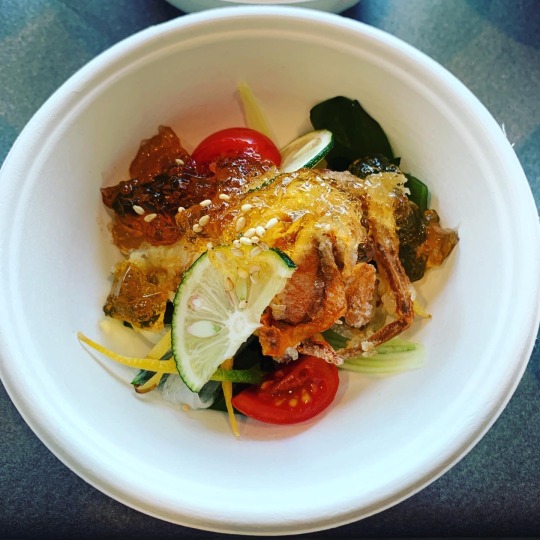
La marinade de crabe par la cheffe Masayo Hashimoto ©TokyoatParis
Côté gastronomie, ce sont les agrumes qui semblent être les spécialités de cette région, en attestent trois recettes de dégustation proposées avec des produits de Tokushima, tous réalisées par la cheffe du restaurant Momoka (Paris 9ème), Masayo HASHIMOTO : une marinade de crabe mou et Naruto wakame à la gelée de Tosazu (à base de vinaigre de riz et de bouillon dashi) -et que je n’ai pas goûté en raison d’intolérance aux crustacés, un chirashi au parfum de Sudachi (une sorte de mini citron vert), et un wagyu à la sauce yuzurikko accompagné de truffe.

Le chirashi par la cheffe Masayo Hashimoto ©TokyoatParis

Le wagyu sauce yuzurikko par la chef Masayo Hashimoto ©TokyoatParis
Mon coup de coeur allait vers ce dernier, un vrai délice et puis généreux en truffe ! La sauce yuzurikko est une sorte de pâte de miso au yuzu donnant une légère acidité et un goût sucré et qui accompagnait parfaitement le plat. Et il semble que cette sauce soit vendue chez Workshop Issé !

La pate yuzurikko est en vente chez Issé d’après l’étiquette au dos du produit ©TokyoatParis
Je suis sûre que cette sauce saurait parfaitement agrémenter un simple bol de riz. Outre ces ingrédients, Tokushima a certaines spécialités culinaires comme le râmen qui a pour particularité dans cette région d’être servi avec un oeuf cru à diluer. Vous pouvez aussi y trouver le Minami Awa Don, le Hirara yaki (sorte de pierrade) ou encore des pâtisseries à base de patate douce ou Naruto Kintoki.

Les trois saké présentés à la Maison de l’UNESCO ©TokyoatParis
Quand on parle de gastronomie japonaise, on ne peut pas ne pas parler de nihonshu ! Trois sakés ont été proposés durant cette dégustation à la Maison de l’UNESCO, dont un Junmai (Narutotai Junmai Genshu Mizu to Kome), qui a obtenu une médaille de platine à Kura Master 2019 ! Ce n’est néanmoins pas mon préféré, mon coup de coeur allant vers le Junmai Daiginjyo appelé Ayane de chez Miyoshikiku Shuzo. A ceux qui se poseraient la question : oui, le Salon du Saké approche à grands pas (c’est ce week-end !), mais a priori non, il n’y aura pas spécifiquement de saké de Tokushima. Mais peut-être en trouverez-vous sur un des stands de distributeurs ?
Tokushima se trouvant à 1h30 d’avion depuis Tôkyô Haneda, ou à un peu plus de 4h en Shinkansen et trains rapides depuis Ôsaka, il n’y a aucune raison de ne pas s’y rendre ! Il existe en plus de nombreux patrimoines naturels à découvrir. Peut-être avez-vous relevé que je parlais de Naruto wakamé ? Il s’agit d’algues de Naruto, non pas comme le célèbre personnage de manga mais plutôt comme la ville éponyme où se trouve le tourbillon de Naruto (Naruto no Uzushio) ! C’est un phénomène naturel observable depuis une plateforme passant au-dessus ou depuis un bateau. Parmi de nombreuses choses à visiter, il se trouve à l’opposé de Naruto la vallée d’Iya qui devrait faire le bonheur des randonneurs et où se trouvent également les gorges d’Oboke. Oboke Iya est en prime une station de onsen avec des ryokan pour vous héberger et ainsi profiter non seulement de visiter et profiter du paysage mais aussi de vous relaxer après une bonne journée de visite dans un bain. Personnellement, c’est là que j’irai si un jour j’ai l’occasion de visiter Tokushima.
Pour en savoir plus sur Tokushima (en anglais), cliquez ici.
Remerciements à Pasona Noentai
Toute reproduction interdite sans mention de la source et du copyright.
2 notes
·
View notes
Text
How To Order Online An Amazing Poke Bowl In Roslyn?
The world is chanting the new mantra ‘eat healthy to stay healthy.’ Perhaps you are doing the same. But saying goodbye to unhealthy eating habits is not easy, especially when you are used to eating processed foods and ready-to-eat snacks almost every day. So, what should you do to make the needed switch to healthy foods? Look for alternatives, like poke bowls, that are both healthy and delicious.
Easy-to-customize poke bowls contain raw fish, vegetables, rice, and traditional Japanese ingredients. If your demanding schedule keeps you from preparing them at home, you can order online an amazing poke bowl In Roslyn whenever you want to savor a delicious meal while keeping your health and weight in check. Here are a few things to focus on when ordering poke bowl online:
Choose the base
A poke bowl contains a base of brown sushi rice, white sushi rice, and mixed greens. Greens are rich in minerals and vitamins, and therefore, highly beneficial to health. Adding greens is recommended if you are trying to establish an active lifestyle and need nutrient-dense meals to fuel your body for physical activities. You can choose white sushi rice for taste or consider brown sushi rice, which is a healthy alternative. It all depends on your personal preferences. That being said, don’t go overboard when choosing the amount of base. If you are on a low-carb diet and trying to lose weight, it’s recommended to limit the amount of the bowl base.
Add some protein
Traditional poke bowls contain dices of raw ahi tuna, but you can add protein of your likes. Whether you prefer wild yellowfin tuna, tea-smoked chicken, or organic salmon, you can have it added to your bowl when ordering an amazing poke bowl in Roslyn online. If you follow a vegan-friendly diet, consider adding tofu cubes to your bowl. After including power-packed protein in the bowl, you need to select the sauce. You will come across various dressings, including yuzu toasted rice vinegar ponzu, smoked-soy yakitori, white soy-ginger marinade, and Gojuchang special sauce. Take your pick to enjoy a healthy meal.
Finish with add-ons
Your poke bowl is incomplete with fresh, nutrient-rich toppings. You can add pickled cucumbers and radishes or include crispy onions and garlic for crunchiness. To make it spicy, include jalapenos and red peppers. Broccoli, kimchi, and macadamia nuts are excellent options if you want healthy ingredients in the bowl. Those who prefer fruits can choose pineapples and mangoes as toppings for their flavorsome poke bowl. You can always ask for recommendations when ordering online if you are new to poke bowls.
Poke bowl is a nutritious meal if you follow a protein-rich, low-carb diet plan. Order online an amazing poke bowl in Roslyn now!
Author’s Bio – The author is an online blogger. This article is about ordering an online poke bowl
1 note
·
View note
Text
The Las Vegas Golden Knight seared the Seattle Kraken, and I can improve its recipe

I appreciate cooking on the ice.
Tuesday night gave us not just the first game of the 2021-22 NHL season, and the inaugural game of the Seattle Kraken — but also the first example of hockey food preparation, courtesy of the Las Vegas Golden Knight.
youtube
Standing on the team’s crest, the Knight sears the Kraken with what I assume is the power of sunlight. The achieved goal is the same, the charred squid retreats to the briny depths to lick its wounds and fight another day.
As someone with a profound love of squid as a go-to protein, much to the chagrin of my wife who doesn’t like it, I have some strong opinions about grilling and searing cephalopods. At high heat it requires a deft hand, good sense of timing, and proper preparation to avoid the unfair labeling of squid as “chewy” or “rubbery.”
While I appreciate the Golden Knight’s inherent technique of “burn it with fire,” I think a little nuance could really improve the mascot’s cooking game.
No. 1: Massage the octopus/squid, if you want to go that far
I’ll freely admit I’ve only done this step once. I skip it, largely out of laziness — but I promise, it does make a difference. The two big inspirations for squid massage come from Greece and Japan.
In Greece you’ll routinely see fishermen and chefs hold the squid by the tentacles and bash is over seaside rocks while the water washes over them. This is pretty basic, and is akin to using a meat tenderizer on a tough piece of steak. You break down the long protein strands, making them easier to chew.
Japanese culture goes a step further. A starting job at a lot of sushi restaurants is “octopus massager,” where you key duty along with washing dishes is to massage the octopus in a bowl with salt for 20-30 minutes prior to service. It’s a more gentle technique, better suiting raw preparation — but essentially achieves the same thing.
No. 2: Marinade is your friend if you’re lazy
I prefer a more passive approach when it comes to tenderizing, which is the tried and true “soak it in acid for a while.” To this end I have two main blends: One is Mediterranean using olive oil, garlic, lemon juice, salt and pepper. The other is Asian inspired, using soy sauce, garlic, rice vinegar, a touch of sesame oil, and the chili paste Sambal Oelek — which is a gift from God.
Seal it up in a bag tightly, stick it in the fridge, give it at least an hour.
No. 3: High heat, short time
I’m far from an expert in the ways of tentacle delicacies, but I’ve learned you really want very high heat and short time. A grill is totally workable, but honestly, I’ve just come to prefer using my much-loved, well-seasoned cast iron skillet
Get that thing roaring hot, add just a touch of high-heat oil and sear larger octopus for 3-4 minutes a side like a mid-rare steak, and no more than a minute or two on a smaller squid. This will cook quickly, and overcooking is your mortal enemy — just like scallops.
Finish with a squeeze or lemon or yuzu and enjoy.
So, why squid and octopus?
As I get older I’m becoming naturally more concerned for the future of our food chains. When it comes to seafood octopus and squid are pretty much the perfect food we should all be eating more of.
They are innately resistant to climate change, making them more immune to environmental pressure.
They grow to full size in 1-2 years vs. 2-5 years for salmon, or 3-5 years for tuna.
They’re extremely low in calories and fat, while being very high in protein by weight.
They’re low-moderate in mercury, compared to other seafood.
The downside?
They’re incredibly intelligent. Easily smarter than some people I’ve interacted with — and that feels bad.
0 notes
Text
Read (PDF/Books) The Japanese Grill: From Classic Yakitori to Steak, Seafood, and Vegetables [a Cookbook] by Tadashi Ono

Read/Download Visit :
http://en.ebookcorner.xyz/?book=158008737X
Book Details :
Author : Tadashi Ono
Pages : 184 pages
Publisher : Ten Speed Press
Language :
ISBN-10 : 158008737X
ISBN-13 : 9781580087377
Book Synopsis :
Read Online and Download The Japanese Grill: From Classic Yakitori to Steak, Seafood, and Vegetables [a Cookbook] .American grilling, Japanese flavors. In this bold cookbook, chef Tadashi Ono of Matsuri and writer Harris Salat share a key insight: that live-fire cooking marries perfectly with mouthwatering Japanese ingredients like soy sauce and miso.Packed with fast-and-easy recipes, versatile marinades, and step-by-step techniques, The Japanese Grill will have you grilling amazing steaks, pork chops, salmon, tomatoes, and whole chicken, as well as traditional favorites like yakitori, yaki onigiri, and whole salt-packed fish. Whether you use charcoal or gas, or are a grilling novice or disciple, you will love dishes like Skirt Steak with Red Miso, Garlic-Soy Sauce Porterhouse, Crispy Chicken Wings, Yuzu Kosho Scallops, and Soy Sauce-and-Lemon Grilled Eggplant. Ono and Salat include menu suggestions for sophisticated entertaining in addition to quick-grilling choices for healthy weekday meals, plus a slew of delectable sides that pair well with anything off the fire.Grilling has been a .
Tadashi Ono book The Japanese Grill: From Classic Yakitori to Steak, Seafood, and Vegetables [a Cookbook].
s
0 notes